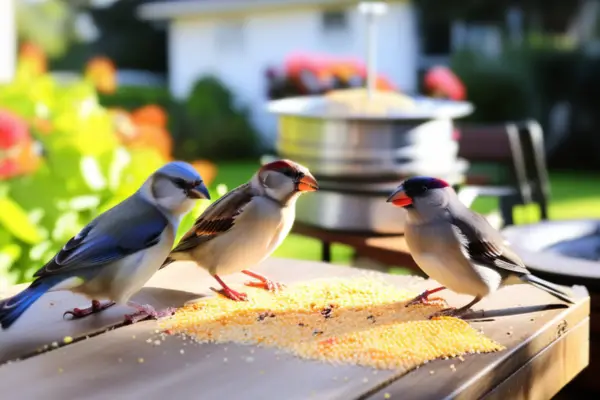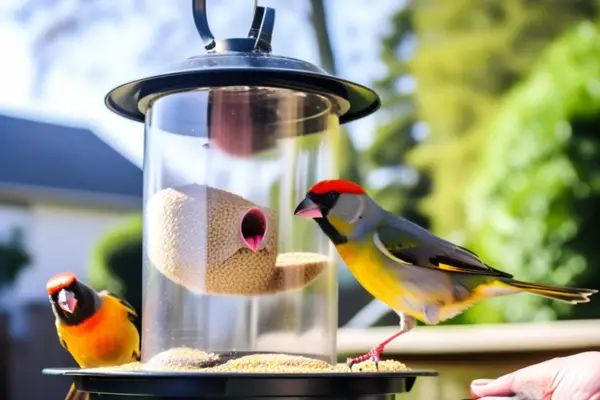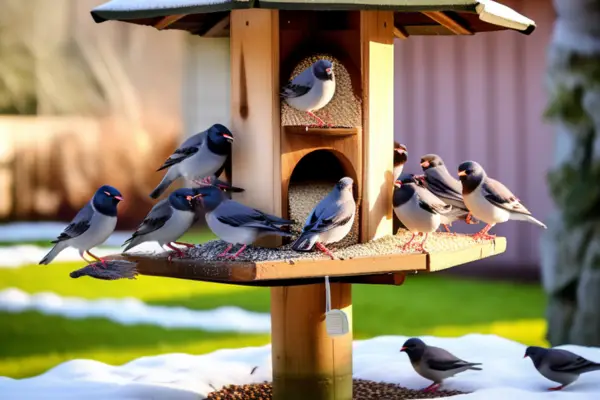Transform Your Backyard into a Feathered Fiesta
Imagine stepping outside your back door and being greeted by a chorus of chirps and tweets. Cardinals flash their vibrant plumage, chickadees flit between branches, and hummingbirds hover, jewels against the green leaves.
This vibrant scene isn’t just a charming picture; it’s a reality you can create by attracting and feeding birds in your own backyard.
Beyond the sheer delight of witnessing feathered friends, there are compelling reasons to welcome birds into your space. Birdwatching is a stress-relieving pastime, connecting you with nature and fostering a sense of wonder. These chirping neighbors also act as natural pest control, gobbling up harmful insects that might otherwise plague your garden. Moreover, by providing food and shelter, you contribute to the delicate balance of the local ecosystem, supporting biodiversity and conservation efforts.
This guide equips you with the knowledge and tools to transform your backyard into a haven for feathered visitors. Get ready to witness the magic unfold!
Planning Your Bird Buffet
A. Choosing the Right Feeders:
Birds come in all shapes and sizes, and so should their dining options! Here’s a quick rundown of popular feeder types:
- Ground feeders: Perfect for robins, sparrows, and juncos, these scatter seeds on the ground.
- Platform feeders: Open trays attracting a variety of birds like cardinals, finches, and woodpeckers.
- Tube feeders: Great for smaller birds like chickadees and nuthatches, offering protection from larger ones.
- Suet feeders: Caged feeders filled with suet cakes, ideal for woodpeckers, nuthatches, and chickadees in colder months.
- Hummingbird feeders: Specialized feeders filled with nectar, attracting these dazzling aerial acrobats.
Material matters: Opt for durable, easy-to-clean feeders like metal or plastic. Squirrel-resistant designs can save you seed and frustration.
Placement is key: Hang feeders away from windows to prevent collisions. Locate them near trees or shrubs for easy escape from predators. Consider placing ground feeders close to cover, like bushes.

B. Selecting the Best Birdseed:
Not all seeds are created equal! Here’s a quick guide:
- Black-oil sunflower seeds: A crowd-pleaser for many birds, offering high fat content for energy.
- Nyjer seed (thistle): Attracts finches with its tiny size and rich oil content.
- Suet cakes: High-energy food source perfect for winter, attracting woodpeckers, chickadees, and nuthatches.
- Mixed seed: Offers variety but can attract undesired birds. Choose specific seed mixes based on your target birds.
Freshness is vital: Avoid moldy or old seeds, and store them in airtight containers.
Minimize mess: Opt for feeders with smaller openings and place them away from patios or decks.
Remember: Avoid harmful fillers like millet or milo, which offer little nutritional value.
C. Creating a Bird-Friendly Habitat:
Think beyond feeders! Attract birds naturally by creating a welcoming habitat:
- Plant native trees, shrubs, and flowers: These provide natural food sources like berries, nuts, and insects, attracting a wider variety of birds.
- Offer water: A birdbath or small pond provides essential hydration and attracts thirsty birds. Keep the water clean and fresh.
- Create safe havens: Plant trees and shrubs to offer nesting sites and shelter from predators. Consider adding nesting boxes for specific bird species.

Maintaining Your Bird Oasis
A. Regular Cleaning and Hygiene:
Disease can spread through dirty feeders. Here’s how to keep things clean:
- Clean feeders once every two weeks with a mild soap solution. Rinse thoroughly and let them dry completely before refilling.
- Remove old seed and debris regularly. This prevents mold growth and attracts fewer unwanted animals.
- Empty and clean birdbaths weekly. Use a scrub brush and fresh water to prevent mosquito breeding.
B. Monitoring and Adapting:
Be an observant host! Watch your feathered guests and adjust your offerings accordingly:
- Observe: Notice which birds visit and what they seem to prefer. Do some research to identify them and learn their specific needs.
- Adapt: If certain feeders remain untouched, swap them for different types or try new seed mixes.
- Address conflicts: Squirrels can be pesky. Use squirrel-proof feeders or create designated feeding areas for them to minimize their impact.
Enjoying the Rewards
A. The Beauty and Benefits of Backyard Birds:
Your efforts will be rewarded with a vibrant backyard ecosystem:
- Witness diverse species: From tiny hummingbirds to majestic hawks, a variety of birds might grace your backyard, each with unique behaviors and songs. Observe their fascinating social interactions, intricate plumage, and graceful flight patterns.
- Support your local ecosystem: By providing food and shelter, you directly contribute to the well-being of birds in your area. This promotes biodiversity and helps maintain the delicate balance of the natural world.
- Enhance your well-being: Studies show that watching birds can reduce stress, improve mood, and boost feelings of calmness and connection to nature. Enjoy the peaceful ambiance and the joy of witnessing these feathered wonders.

B. Tips for Birdwatching and Photography:
Become a citizen scientist and deepen your connection with your feathered friends:
- Identify bird species: Invest in a field guide specific to your region or use online resources like the Cornell Lab of Ornithology’s Merlin app.
- Observe quietly: Patience is key. Sit still and avoid sudden movements to allow birds to approach comfortably.
- Embrace basic photography: Capture stunning photos with a telephoto lens or even your smartphone camera. Start by focusing on birds at feeders or birdbaths.
Conclusion
Transforming your backyard into a haven for birds is a rewarding journey, filled with learning, discovery, and connection with nature. Remember, the key lies in providing a variety of food sources, maintaining hygiene, and creating a welcoming habitat.
Start small, observe your feathered guests, and adapt your approach based on their needs. As you do, your backyard will blossom into a vibrant symphony of chirps, feathers, and life, enriching your own life and contributing to the well-being of our feathered friends.
Bonus Tips:
- Engage with your local community: Join birdwatching clubs or online forums to connect with other enthusiasts and learn from their experiences.
- Support bird conservation: Donate to organizations dedicated to bird research and habitat protection.
- Spread the joy: Share your love for birds with friends and family, inspiring them to create their own backyard havens.
Remember, with a little effort and dedication, you can transform your backyard into a feathered paradise, fostering a beautiful connection with nature and enriching your life in countless ways. So, step outside, listen to the birdsong, and witness the magic unfold!


